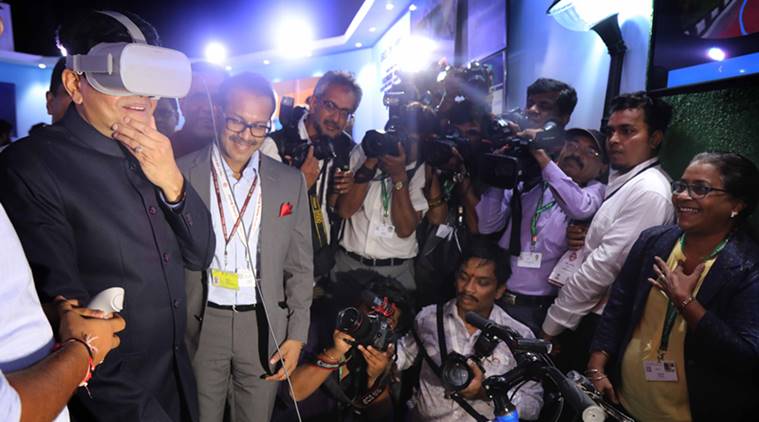Through A Wider Lens
AIIB meeting presents an opportunity to redefine the parameters of development.

Finance Minister Piyush Goyal inspects a VR for an advanced cycling simulation application. (Express photo by Nirmal Harindran)
Budha Ismail Jam, a fisherman from Kutch, will be unknown to most delegates at the Asian Infrastructure Investment Bank’s (AIIB) annual meeting being held in Mumbai on June 25-26. Yet, Jam’s story has far-reaching implications if infrastructure projects are to be more focused on the well-being of people rather than the profit margins of investors.
The third annual meeting of the AIIB’s Board of Governors is happening 21 years after “Triple Bottom Line” — namely People, Planet, Profits — was brought into the lexicon of global business. Whether this concept is fully operationalised by the AIIB might be far more important than the geopolitics of nation-states that tend to grab centrestage in this newly-minted international finance institution (IFI).
Jam’s story is significant because it demonstrates, sadly, that the best practices of relatively conscientious investors and corporations are often inadequate. The case pertains to Tata Power’s Mundra plant, financed partly by a $450-million loan from the International Finance Corporation (IFC), which caused extensive damage to the local ecosystem and thus the livelihoods of fisherfolk and farmers. Jam is the lead plaintiff in a case filed in the US, in which the project-affected people are suing the IFC for damages. In May, in an unprecedented move, the US Supreme Court admitted the case and will give a judgment on whether the immunity granted to the IFC by international law is valid.
Ironically, both the IFC and Tatas have internal mechanisms to monitor social and environmental impacts of the projects, clearly to no avail. This is only partly because most infrastructure projects are still designed with local realities being considered at second place or lower. Most IFIs do not seriously engage with the so-called fringe voices who are clamouring for “development” to be equated with the revitalisation of local economies. Instead of an empowerment handed down to those at the bottom of the pyramid, these voices seek to abolish the pyramidical nature of the global economy.
From this perspective, much of the emerging discourse on “sustainable infrastructure” within IFIs, including the AIIB, appears meaningless because it is, at best, about ameliorative concessions on social justice issues. There is no room for re-examining core assumptions.
For example, projections about the amount of energy and roads needed in the coming decades would be quite different depending on how the nature of production systems and concentration of populations is visualised. At present, even though the American and West European model of development is widely acknowledged as unsustainable, it remains the reference point for “world class” infrastructure. For instance, India’s Sagarmala project is designed to provide rapid connectivity through a string of ports and across 14 Coastal Economic Zones. The perspective and priorities of communities are treated as incidental. It is assumed that they will somehow benefit from the trickle down of the economic activity generated by these investments. This is why conflicts with local people become inevitable.
Since the AIIB was set up in 2016, long after older IFIs had learnt these lessons the hard way, it was expected to build upon those experiences and set higher standards. On the contrary, according to the Delhi-based NGO, Working Group on International Financial Institutions, the AIIB’s standards are lower than those of older IFIs — notably the World Bank group.
With billions projected to be invested by the AIIB in India, local activist groups are mobilising to create pressure for change. Many of them gathered at a People’s Convention on Infrastructure Financing in Mumbai last week, where Jam was present to seek solidarity for the battle to challenge immunity to IFIs.
The AIIB leadership, along with policymakers of its two largest members, China and India, could well choose to overlook these voices. It would be easy for them to ignore Jam and claim that international laws giving immunity to IFIs are essential and cannot be overturned because of the unrest of a few thousand residents of the Kutch coast. This course of action would set up the AIIB for protracted struggles with local people.
Or, the first-ever meeting of the AIIB board in India could prove to be of historical significance if it leads to a willingness to look at the future with a wider lens. The People’s Convention has made detailed inputs to the AIIB proceedings in specific areas — such as urban infrastructure, smart cities, water management, industrial corridors, blue economy.
These inputs will be far from complete or ready to apply. But the onus for turning these views into action does not rest primarily with those fighting for basic human rights of food, shelter, livelihoods at the grassroots. It must be a collective exercise involving those in power and those speaking truth to power.
The writer is a Mumbai-based author
For all the latest Opinion News, download Indian Express App
More From Rajni Bakshi
- King’s WayAs King tirelessly reiterated — we will not learn non-violence from a guru or a saint. We can only learn it by loving whoever we…
- What Our Anthems SaySouth Asia’s national anthems are patriotic rather than nationalistic...








































No hay comentarios:
Publicar un comentario